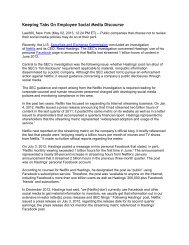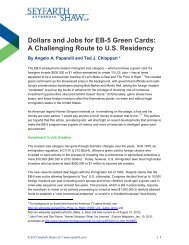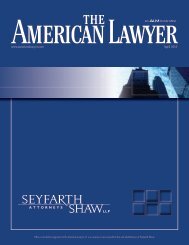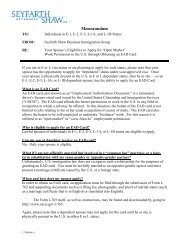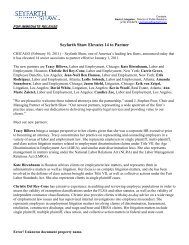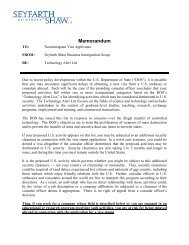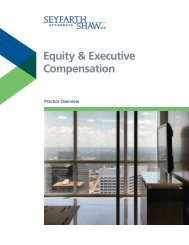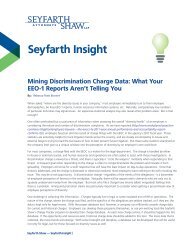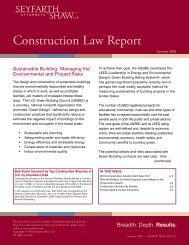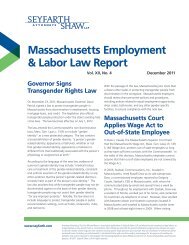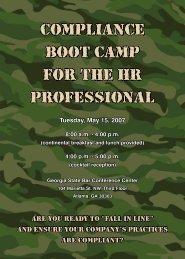Litigating California Wage & Hour and Labor Code Class Actions
Litigating California Wage & Hour and Labor Code Class Actions
Litigating California Wage & Hour and Labor Code Class Actions
Create successful ePaper yourself
Turn your PDF publications into a flip-book with our unique Google optimized e-Paper software.
who does not meet the threshold compensation test is automatically disqualified from the<br />
exemption.<br />
The other requirements are that the manager (1) must have the power to hire <strong>and</strong> fire, or<br />
make recommendations on those topics that are given particular weight; (2) must supervise<br />
at least two full-time equivalent positions; (3) must “primarily” be engaged in managerial<br />
duties; <strong>and</strong> (4) must “customarily <strong>and</strong> regularly” exercise discretion <strong>and</strong> independent<br />
judgment. 13<br />
Most litigation in <strong>California</strong> arises out of element (3) above, because the <strong>California</strong><br />
Supreme Court in Ramirez v. Yosemite Water Co. 14 held that an employee meets element<br />
(3) only when the employee spends more than half of the work time on exempt duties. By<br />
contrast, under the FLSA’s executive exemption, the employer need only establish that<br />
management is the employee’s “primary duty,” which focuses on the relative importance of<br />
the duty rather than just the amount of time devoted to the duty. 15<br />
Aside from its emphasis on the percentage of work time devoted to exempt duties, there<br />
has been little <strong>California</strong> case law explaining precisely which duties qualify as exempt<br />
“managerial work.” Since July 2000, however, the <strong>Wage</strong> Order has expressly incorporated<br />
by reference the then-existing FLSA regulations defining “managerial” duties. 16<br />
Accordingly, federal authority construing those specific regulations is highly relevant in<br />
interpreting the <strong>California</strong> executive exemption. 17<br />
Some examples of exempt work set forth in the federal regulation are interviewing,<br />
selecting <strong>and</strong> training employees, setting <strong>and</strong> adjusting pay rates <strong>and</strong> work hours, directing<br />
work, keeping production records for subordinates, evaluating employees’ efficiency <strong>and</strong><br />
13<br />
14<br />
15<br />
16<br />
17<br />
See IWC <strong>Wage</strong> Order 1-2001(1)(A)(1); Nordquist v. McGraw-Hill Broad. Co., 32 Cal. App. 4th 555, 573 (1995)<br />
(“‘Discretion <strong>and</strong> independent judgment’ within the meaning of IWC Order No. 11-80 involves the comparison of<br />
possible courses of conduct, <strong>and</strong> acting after considering various possibilities. It implies that the employee has the<br />
power to make an independent choice free from immediate supervision <strong>and</strong> with respect to matters of significance . . .<br />
[meaning matters] of substantial significance to the policies or general operations of the business of the employer.”).<br />
20 Cal. 4th 785 (1999).<br />
Id. at 797; see also Baldwin v. Trailer Inns, Inc., 266 F.3d 1104, 1113-16 (9th Cir. 2001) (although store managers<br />
spent less than one-half their time on duties that met the federal executive exemption, they still qualified as exempt<br />
because management was found to be their “primary” or most important duty).<br />
See Whiteway v. FedEx Kinko’s Office & Print Servs., Inc., 2007 U.S. Dist. LEXIS 61239; 12 <strong>Wage</strong> & <strong>Hour</strong> Cas. 2d<br />
(BNA) 1503 (N.D. Cal. Aug. 21, 2007) (citing IWC <strong>Wage</strong> Order 7-2001 § (1)(A)(1)(e) <strong>and</strong> noting that it incorporates the<br />
federal definition of management as set forth in 29 C.F.R. § 541.102).<br />
See Whiteway, 2007 U.S. Dist. LEXIS 61239, at *22 (relying on federal cases construing 29 C.F.R. § 541.202 to<br />
interpret <strong>California</strong> executive exemption); see also Bldg. Material & Constr. Teamsters Union v. Farrell, 41 Cal. 3d 651,<br />
658 (1986) (“[f]ederal decisions have frequently guided our interpretation of state labor provisions the language of which<br />
parallels that of federal statutes”); Alcala v. Western Agric. Enters., 182 Cal. App. 3d 546, 550 (1986) (“It has been held<br />
that when <strong>California</strong>’s laws are patterned on federal statutes, federal cases construing those federal statutes may be<br />
looked to for persuasive guidance”).<br />
Seyfarth Shaw LLP | www.seyfarth.com <strong>Litigating</strong> <strong>California</strong> <strong>Wage</strong> & <strong>Hour</strong> <strong>Class</strong> <strong>Actions</strong> (12th Edition) 7



